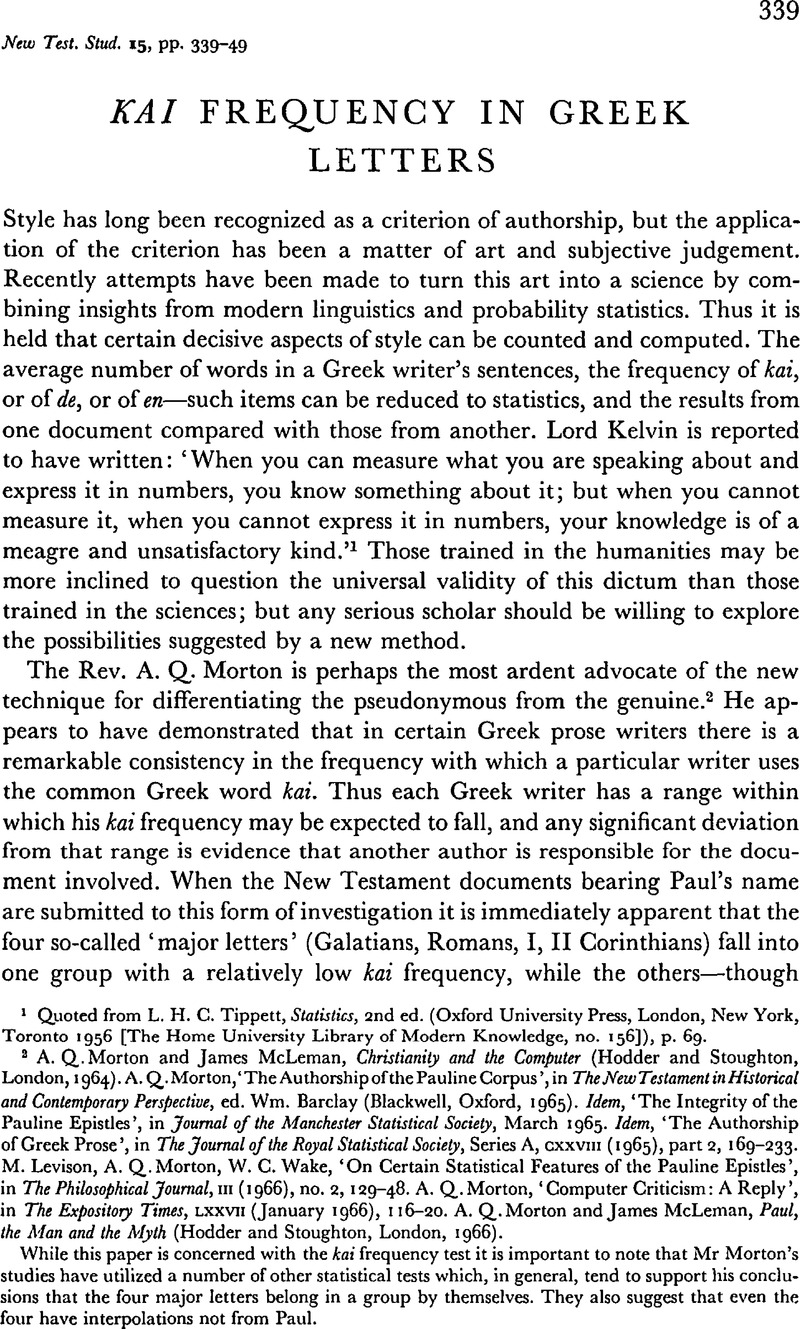Published online by Cambridge University Press: 05 February 2009

page 339 note 1 Quoted from Tippett, L. H. C., Statistics, 2nd ed. (Oxford University Press, London, New York, Toronto 1956 The Home University Library of Modern Knowledge, no. 156), p. 69.Google Scholar
page 339 note 2 Morton, A. Q. and McLeman, James, Christianity and the Computer (Hodder and Stoughton, London, 1964).Google ScholarMorton, A. Q., ‘The Authorship of the Pauline Corpus’, in The New Testament in Historical and Contemporary Perspective, ed. Barclay, Wm. (Blackwell, Oxford, 1965).Google Scholar Idem, ‘The Integrity of the Pauline Epistles’, in Journal of the Manchester Statistical Society, March 1965. Idem, ‘The Authorship of Greek Prose’, in The Journal of the Royal Statistical Society, Series A, cxxviii (1965), part 2, 169–233.Google ScholarLevison, M., Morton, A. Q., Wake, W. C., ‘On Certain Statistical Features of the Pauline Epistles’, in The Philosophical Journal, III (1966), no. 2, 129–48.Google ScholarMorton, A. Q., ‘Computer Criticism: A Reply’, in The Expository Times, LXXVII (01 1966), 116–20.CrossRefGoogle ScholarMorton, A. Q. and McLeman, James, Paul, the Man and the Myth (Hodder and Stoughtion, London, 1966).Google Scholar
While this paper is concerned with the kai frequency test it is important to note that Mr Morton's studies have utilized a number of other statistical tests which, in general, tend to support his conclusions that the four major letters belong in a group by themselves. They also suggest that even the four have interpolations not from Paul.
page 340 note 1 Morton, and McLeman, , Christianity and the Computer, pp. 32 f., 92.Google Scholar
page 340 note 2 Morton, , ‘The Authorship of Greek Prose’, p. 170.Google ScholarWake, W. C., ‘Sentence Length Distribution of Greek Authors’, in Journal of the Royal Statistical Society, Series A, CXX, (1957), part 3, 331–46, esp. p. 341.CrossRefGoogle Scholar
page 340 note 3 See the article ‘Computer Criticism’ in The Expository Times, LXXVI, (1965), no. 12, 367–70.Google Scholar
page 340 note 4 Morton, ‘Computer Criticism: A Reply’, loc. cit. LXXVII (1966), no. 4, 116–20.
page 340 note 5 It is not quite so clear why Marcus Aurelius should not be accepted as a writer of standard Greek prose.
page 341 note 1 Epistolographi Graeci (Paris, 1873).Google Scholar
page 342 note 1 There are many informal letters scattered through out the volumes of The Oxyrhychus Papyri. The longest I have noted is just over 20 sentences. See Letter to Theon, XVIII, col. 2, 190, 145–7.
page 343 note 1 The text used was that of Benner, A. R., and Fobes, F.H. in The Loeb Classical Library (London, William Heinemann, 1914; Cambridge, Mass, The Harvard University Press.Google Scholar
page 343 note 2 The text used was that of Deferrari, R. J. in The Loeb Classical Library, 4 vols. (London, William Heinemann, 1926–1934; New York, The Macmillan Company).Google Scholar
page 344 note 1 The text used was that of the Patrologia Graeca, LXXVII, edited by Migne, J., Paris, 1859.Google Scholar
page 344 note 2 Here, and wherever else ‘200’ appears, it means that the writing was relatively lengthy and only the first 200 sentences were used.
page 344 note 3 The text used was that of Lake, K. in The Loeb Classical Library (London, William Heinemann, 1912; New York, The Macmillan Company).Google Scholar It must be remembered that the accepted text of the seven Ignatian letters is not necessary the original text.
page 345 note 1 There is, admittedly, no explicit evidence that Paul and Ignatius were non-professionals, but this would probably be the judgement of those most competent to evaluate their style of writing.
page 345 note 2 The text used was that of Foerster, R., Bibliotheca Teubneriana, vols. X, and XI, of the works of Libanius (Leipzig, 1921, 1922).Google Scholar
page 345 note 3 The statistics used for Paul are taken from Mr Morton's writings. See Christianity and the Computer, p. 92. My own count is slightly different. It should be noted that probably no two individuals would produce identical statistics since they vary with the text used, the accuracy of the count, and the identification of sentences. It is important to note that a ‘sentence’ in these discussions is understood to mean a series of words ending with a grammatical full stop—whether that full stop be a period, question mark, exclamation point or colon. (There is, of course, no semi-colon in Greek.) Fortunately slight variations in counting do not affect the overall statistical picture.
page 347 note 1 The text used was that of the Oxford edition by J. Burner, 1906.
page 347 note 2 See Christianity and the Computer, p. 93. See also p. 30, and ‘The Authorship of Greek Prose’, pp. 169–70, for Morton's references to Plato's Letter no. 7.
page 347 note 3 The text used was that of the Patrologia Graeca, ed. by Migne, J., LXVI, (Paris, 1859).Google Scholar
page 348 note 1 Paul is not listed here since it is the authenticity of the letters attributed to him which is in dispute. Plato is omitted also because the letters bearing his name are disputed.
page 348 note 2 It is important to remember that Mr Morton has presented additional statistical evidence bearing on the stylistic differences between Romans, Galatians, I and II Corinthians on the one hand, and the other letters purporting to be Pauline. This study has concentrated on one strand of the evidence, namely the frequency of kai.